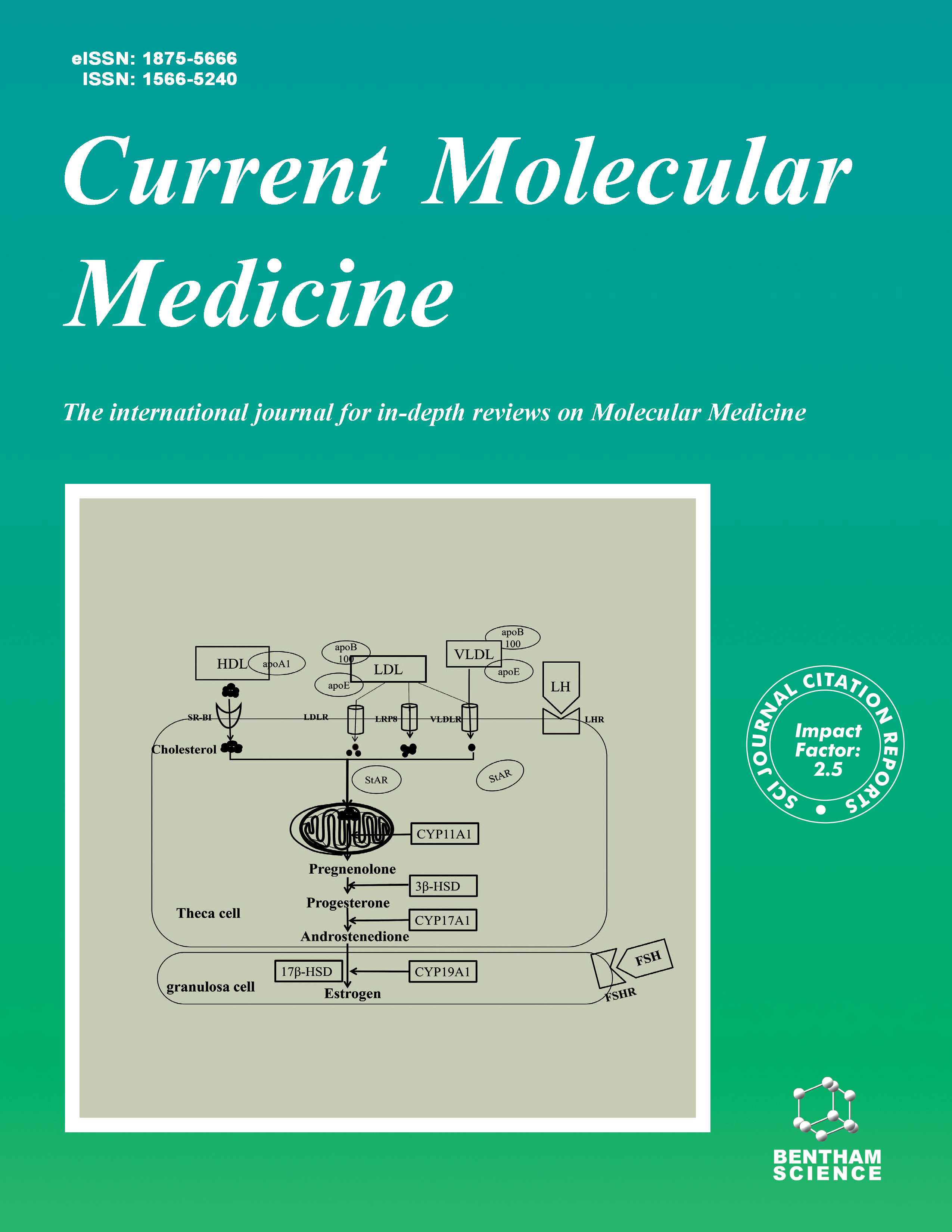- Home
- A-Z Publications
- Current Molecular Medicine
- Previous Issues
- Volume 23, Issue 1, 2023
Current Molecular Medicine - Volume 23, Issue 1, 2023
Volume 23, Issue 1, 2023
-
-
Molecular Pathways, Targeted Therapies, and Proteomic Investigations of Colorectal Cancer
More LessAuthors: Azmi Yerlikaya and Sezgin ZerenAccording to the GLOBOCAN 2020 data, colorectal cancer is the third most commonly diagnosed cancer and the second leading cause of cancer-related death. The risk factors for colorectal cancer include a diet abundant with fat, refined carbohydrates, animal protein, low fiber content, alcoholism, obesity, long-term cigarette smoking, low physical activity, and aging. Colorectal carcinomas are classified as adenocarcino Read More
-
-
-
Free Radicals and Oxidative Stress: Signaling Mechanisms, Redox Basis for Human Diseases, and Cell Cycle Regulation
More LessFree radicals contain one or more unpaired electrons in their valence shell, thus making them unstable, short-lived, and highly reactive species. Excessive generation of these free radicals ultimately leads to oxidative stress causing oxidation and damage to significant macromolecules in the living system and essentially disrupting signal transduction pathways and antioxidants equilibrium. At lower concentrations, ROS serves Read More
-
-
-
The Determinative Role of Cytokines in Retinopathy of Prematurity
More LessAuthors: Seyed A. Rasoulinejad and Pegah KiyamehrRetinopathy of prematurity (ROP) is a neonatal disease corresponding to vision impairment and blindness. Utilizing the pathogenesis of ROP and the risk factors affecting its progression can help prevent and reduce its incidence and lead to the emergence and development of new treatment strategies. Factors influencing retinopathy include growth and inflammatory factors that play an essential role in the pathogenesis of the Read More
-
-
-
Altered Expression of TRIM Proteins - Inimical Outcome and Inimitable Oncogenic Function in Breast Cancer with Diverse Carcinogenic Hallmarks
More LessAuthors: Suman K. Ray and Sukhes MukherjeeDeregulation of ubiquitin-mediated degradation of oncogene products or tumor suppressors appears to be implicated in the genesis of carcinomas, according to new clinical findings. Conferring to recent research, some members of the tripartite motif (TRIM) proteins (a subfamily of the RING type E3 ubiquitin ligases) act as significant carcinogenesis regulators. Intracellular signaling, development, apoptosis, protein quality con Read More
-
-
-
Research Update on the Pathophysiological Mechanisms of Heart Failure with Preserved Ejection Fraction
More LessAuthors: Yuying Zhou, Yunlong Zhu and Jianping ZengHeart failure (HF) is a serious clinical syndrome, usually occurs at the advanced stage of various cardiovascular diseases, featured by high mortality and rehospitalization rate. According to left ventricular (LV) ejection fraction (LVEF), HF has been categorized as HF with reduced EF (HFrEF; LVEF<40%), HF with mid-range EF (HFmrEF; LVEF 40-49%), and HF with preserved EF (HFpEF; LVEF ≥50%). HFpEF accounts for about 50 Read More
-
-
-
An Insight into the Molecular Mechanism of Mitochondrial Toxicant-induced Neuronal Apoptosis in Parkinson’s Disease
More LessParkinson’s disease (PD) is one of the most common progressive neurodegenerative disorders affecting approximately 1% of the world’s population at the age of 50 and above. Majority of PD cases are sporadic and show symptoms after the age of 60 and above. At that time, most of the dopaminergic neurons in the region of substantia nigra pars compacta have been degenerated. Although in past decades, discoveries of Read More
-
-
-
Breviscapine Combined with BMSCs Reduces Aβ Deposition in Rat with Alzheimer's Disease by Regulating Circular RNA ciRS-7
More LessAuthors: Fengqin Sun, Yulin Zhang, Xinran Wu, Xu Xu, Chaodie Zhu and Wei HuangAims: This study aimed to clarify that breviscapine combined with bone marrow mesenchymal stem cells (BMSCs) treatment can reduce Aβ deposition in Alzheimer's disease (AD) patients. Background: AD is a common degenerative disease of the central nervous system. Aβ protein deposition in the cerebral cortex and hippocampus causes neuronal peroxidation damage, synaptic dysfunction, neuroinflammation, an Read More
-
-
-
Cyclosporine Ameliorates Silica-Induced Autoimmune Hepatitis in Rat Model by Altering the Expression of Toll-Like Receptor-4, Interleukin-2, and Tumor Necrosis Factor-α
More LessBackground: Autoimmune hepatitis (AIH) is an inflammatory liver disease that is characterized histologically by interface hepatitis, biochemically by elevated transaminase levels, and serologically by the presence of autoantibodies. Toll-like receptor (TLR)-4 is a TLR family member that, upon activation in hepatocytes, initiates a cascade of events. Interleukin-2 (IL-2) and tumour necrosis factor α (TNF-α) are potent inflammator Read More
-
Volumes & issues
-
Volume 25 (2025)
-
Volume 24 (2024)
-
Volume 23 (2023)
-
Volume 22 (2022)
-
Volume 21 (2021)
-
Volume 20 (2020)
-
Volume 19 (2019)
-
Volume 18 (2018)
-
Volume 17 (2017)
-
Volume 16 (2016)
-
Volume 15 (2015)
-
Volume 14 (2014)
-
Volume 13 (2013)
-
Volume 12 (2012)
-
Volume 11 (2011)
-
Volume 10 (2010)
-
Volume 9 (2009)
-
Volume 8 (2008)
-
Volume 7 (2007)
-
Volume 6 (2006)
-
Volume 5 (2005)
-
Volume 4 (2004)
-
Volume 3 (2003)
-
Volume 2 (2002)
-
Volume 1 (2001)
Most Read This Month
Article
content/journals/cmm
Journal
10
5
false
en


